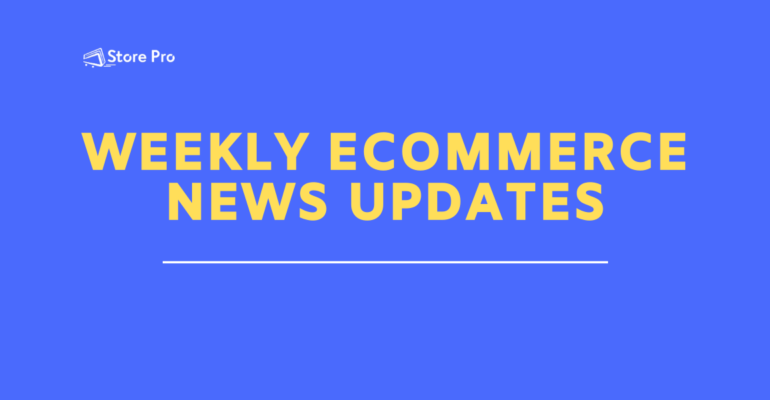Weekly Ecommerce News Updates
Weekly Ecommerce News Updates

FMCG’s E-commerce Penetration in the UK to Hit 9% by 2025
According to Kantar WorldPanel UK, online FMCG sales turned out to be 7.6 percent for a period of 12 months ending in June 2019, compared to the online sales in the same duration, a year ago.
The FMCG (Fast Moving Consumer Goods) sector in the UK witnessed a total growth of 2.4%, both offline and online sales combined. However, the online FMCG growth is 5.9%. The UK leads the online FMCG market in Western Europe with a giant share in online FMCG sales, followed by France and Spain.
Kantar further predicted that online shopping will be almost one-third of FMCG sales in China and one-fourth in South Korea. “The online grocery sales will almost double by 2025. That is, approximately 10% of the global FMCG sales will be happening online,” said Stephane Roger, Director of Retail, Kantar WorldPanel.
The Products with ‘Amazon’s Choice’ Badge Unsafe or Fake
An investigation by Wall Street Journal found that e-commerce giant Amazon gave ‘Amazon’s Choice’ badge to unsafe or fake products. According to the Journal, the label appeared on dozens of products that were banned, didn’t meet safety standards and featured fake safety certifications. The badge was applied to controlled substances like steroids and marijuana products.
Amazon launched Amazon’s Choice badge in 2015 to recommend highly rated products to customers. It has been used as a trust sign by many customers before making a purchase. The investigation also found that Amazon’s Choice’ listings were manipulated with specific keywords that ensured the products were included in the recommended engine.
“We don’t tolerate policy violations. When deciding to badge a product as ‘Amazon’s Badge’ , we proactively incorporate a number of factors that are designed to protect customers from our policy violations,” said an Amazon spokesperson.
US Online Holiday Shopping Sales Hit Record-High
A massive surge in online shopping sales in the U.S. customers was recorded during this year’s holiday shopping season.
A report by Mastercard noted the surge happened despite a compressed holiday shopping season this year. Excluding autos, holiday retail sales jumped 3.4 percent this year. Holiday shopping is a crucial time for all retailers and it accounts for 40 percent of their annual sales.
According to the data by Mastercard, online sales this year constituted 14.6 percent of total retail and marked an increase of 18.8 percent from the 2018 period. The data tracked retail sales from Nov. 1 until Christmas Eve.
“E-commerce sales hit a record high this year with more people doing their holiday shopping online,” said Steve Sadove, a senior adviser for Mastercard. The news of record-breaking holiday sales created a buzz on social media. President Donald Trump took it to Twitter and congratulated America for achieving the feat.
Top 3 Ecommerce Trends 2020
The changes in the ecommerce industry are rapid and 2020 is going to witness inspiring trends in the sector, which will be helpful for store owners to plan their marketing campaigns. We share the top 3 trends for 2020.
1) Amazon is losing the game: Brands don’t need Amazon
Yes, you heard us right. Amazon seems to be losing the game. Recently, anti-Amazon sentiments grew stronger in popular brands. In November this year, sports apparel giant Nike stopped selling its products on Amazon. Besides, counterfeit products on Amazon further dipped the company’s credibility. On the shipping side, Amazon recently locked horns with FedEx. For store owners, platforms like Shopify and WooCommerce will be a good option in 2020.
2) Consumers begin selling their own privacy and data
Consumers have been trading data for access (social media) and rewards (loyalty programs) for decades. Consumers know their data (in-store movement, online browsing, geo-location) is being used. And for the first time, they are coming to the bargaining table, ready to negotiate. Brands and merchants will move from trying to capture as much user data as possible to engaging in an exchange of value.
3) Offbeat marketing strategies work
You cannot survive on those pay per clicks/ view campaigns. Americans see between 4,000 and 10,000 ads daily (up from 500 in the 1970’s) and the “interruption model” is reaching a saturation point, or “Peak Ads”. Consumers are becoming harder and more expensive to reach with traditional digital ads.
More native and offbeat campaigns are playing a crucial role to bag more customers. Brands and merchants are producing content and experiences to create the buzz – simultaneously gathering data and creating direct connections with consumers, instead of relying on the “walled gardens” of Amazon, Facebook and Google.


 Shares
Shares